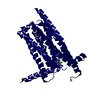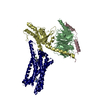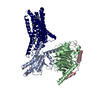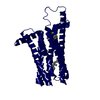+ Open data
Open data
- Basic information
Basic information
| Entry |  | |||||||||
|---|---|---|---|---|---|---|---|---|---|---|
| Title | A local Cryo-EM structure of Bitter taste receptor TAS2R14 | |||||||||
 Map data Map data | ||||||||||
 Sample Sample |
| |||||||||
 Keywords Keywords | GPCR / MEMBRANE PROTEIN | |||||||||
| Function / homology |  Function and homology information Function and homology informationbitter taste receptor activity / taste receptor activity / detection of chemical stimulus involved in sensory perception of bitter taste / Class C/3 (Metabotropic glutamate/pheromone receptors) / G protein-coupled receptor activity / Sensory perception of sweet, bitter, and umami (glutamate) taste / G alpha (i) signalling events / G protein-coupled receptor signaling pathway / membrane / plasma membrane Similarity search - Function | |||||||||
| Biological species |  Homo sapiens (human) Homo sapiens (human) | |||||||||
| Method | single particle reconstruction / cryo EM / Resolution: 3.15 Å | |||||||||
 Authors Authors | Yuan Q / Duan J / Tao L / Xu EH | |||||||||
| Funding support |  China, 1 items China, 1 items
| |||||||||
 Citation Citation |  Journal: Cell Res / Year: 2024 Journal: Cell Res / Year: 2024Title: Bitter taste receptor TAS2R14 activation and G protein assembly by an intracellular agonist. Authors: Lele Tao / Dongxue Wang / Qingning Yuan / Fenghui Zhao / Yu Zhang / Tianyuan Du / Shiyi Shen / H Eric Xu / Yi Li / Dehua Yang / Jia Duan /  | |||||||||
| History |
|
- Structure visualization
Structure visualization
| Supplemental images |
|---|
- Downloads & links
Downloads & links
-EMDB archive
| Map data |  emd_60607.map.gz emd_60607.map.gz | 96.9 MB |  EMDB map data format EMDB map data format | |
|---|---|---|---|---|
| Header (meta data) |  emd-60607-v30.xml emd-60607-v30.xml emd-60607.xml emd-60607.xml | 13.6 KB 13.6 KB | Display Display |  EMDB header EMDB header |
| Images |  emd_60607.png emd_60607.png | 34.6 KB | ||
| Filedesc metadata |  emd-60607.cif.gz emd-60607.cif.gz | 5.3 KB | ||
| Others |  emd_60607_half_map_1.map.gz emd_60607_half_map_1.map.gz emd_60607_half_map_2.map.gz emd_60607_half_map_2.map.gz | 95.6 MB 95.6 MB | ||
| Archive directory |  http://ftp.pdbj.org/pub/emdb/structures/EMD-60607 http://ftp.pdbj.org/pub/emdb/structures/EMD-60607 ftp://ftp.pdbj.org/pub/emdb/structures/EMD-60607 ftp://ftp.pdbj.org/pub/emdb/structures/EMD-60607 | HTTPS FTP |
-Validation report
| Summary document |  emd_60607_validation.pdf.gz emd_60607_validation.pdf.gz | 816.4 KB | Display |  EMDB validaton report EMDB validaton report |
|---|---|---|---|---|
| Full document |  emd_60607_full_validation.pdf.gz emd_60607_full_validation.pdf.gz | 816 KB | Display | |
| Data in XML |  emd_60607_validation.xml.gz emd_60607_validation.xml.gz | 13.3 KB | Display | |
| Data in CIF |  emd_60607_validation.cif.gz emd_60607_validation.cif.gz | 15.5 KB | Display | |
| Arichive directory |  https://ftp.pdbj.org/pub/emdb/validation_reports/EMD-60607 https://ftp.pdbj.org/pub/emdb/validation_reports/EMD-60607 ftp://ftp.pdbj.org/pub/emdb/validation_reports/EMD-60607 ftp://ftp.pdbj.org/pub/emdb/validation_reports/EMD-60607 | HTTPS FTP |
-Related structure data
| Related structure data |  9iiwMC  9iixC  9ij9C  9ijaC M: atomic model generated by this map C: citing same article ( |
|---|---|
| Similar structure data | Similarity search - Function & homology  F&H Search F&H Search |
- Links
Links
| EMDB pages |  EMDB (EBI/PDBe) / EMDB (EBI/PDBe) /  EMDataResource EMDataResource |
|---|---|
| Related items in Molecule of the Month |
- Map
Map
| File |  Download / File: emd_60607.map.gz / Format: CCP4 / Size: 103 MB / Type: IMAGE STORED AS FLOATING POINT NUMBER (4 BYTES) Download / File: emd_60607.map.gz / Format: CCP4 / Size: 103 MB / Type: IMAGE STORED AS FLOATING POINT NUMBER (4 BYTES) | ||||||||||||||||||||||||||||||||||||
|---|---|---|---|---|---|---|---|---|---|---|---|---|---|---|---|---|---|---|---|---|---|---|---|---|---|---|---|---|---|---|---|---|---|---|---|---|---|
| Projections & slices | Image control
Images are generated by Spider. | ||||||||||||||||||||||||||||||||||||
| Voxel size | X=Y=Z: 0.824 Å | ||||||||||||||||||||||||||||||||||||
| Density |
| ||||||||||||||||||||||||||||||||||||
| Symmetry | Space group: 1 | ||||||||||||||||||||||||||||||||||||
| Details | EMDB XML:
|
-Supplemental data
-Half map: #1
| File | emd_60607_half_map_1.map | ||||||||||||
|---|---|---|---|---|---|---|---|---|---|---|---|---|---|
| Projections & Slices |
| ||||||||||||
| Density Histograms |
-Half map: #2
| File | emd_60607_half_map_2.map | ||||||||||||
|---|---|---|---|---|---|---|---|---|---|---|---|---|---|
| Projections & Slices |
| ||||||||||||
| Density Histograms |
- Sample components
Sample components
-Entire : local refinement of TAS2R14
| Entire | Name: local refinement of TAS2R14 |
|---|---|
| Components |
|
-Supramolecule #1: local refinement of TAS2R14
| Supramolecule | Name: local refinement of TAS2R14 / type: complex / ID: 1 / Parent: 0 / Macromolecule list: #1 |
|---|---|
| Source (natural) | Organism:  Homo sapiens (human) Homo sapiens (human) |
-Macromolecule #1: Taste receptor type 2 member 14
| Macromolecule | Name: Taste receptor type 2 member 14 / type: protein_or_peptide / ID: 1 / Number of copies: 1 / Enantiomer: LEVO |
|---|---|
| Source (natural) | Organism:  Homo sapiens (human) Homo sapiens (human) |
| Molecular weight | Theoretical: 36.20007 KDa |
| Recombinant expression | Organism:  |
| Sequence | String: MGGVIKSIFT FVLIVEFIIG NLGNSFIALV NCIDWVKGRK ISSVDRILTA LAISRISLVW LIFGSWCVSV FFPALFATEK MFRMLTNIW TVINHFSVWL ATGLGTFYFL KIANFSNSIF LYLKWRVKKV VLVLLLVTSV FLFLNIALIN IHINASINGY R RNKTCSSD ...String: MGGVIKSIFT FVLIVEFIIG NLGNSFIALV NCIDWVKGRK ISSVDRILTA LAISRISLVW LIFGSWCVSV FFPALFATEK MFRMLTNIW TVINHFSVWL ATGLGTFYFL KIANFSNSIF LYLKWRVKKV VLVLLLVTSV FLFLNIALIN IHINASINGY R RNKTCSSD SSNFTRFSSL IVLTSTVFIF IPFTLSLAMF LLLIFSMWKH RKKMQHTVKI SGDASTKAHR GVKSVITFFL LY AIFSLSF FISVWTSERL EENLIILSQV MGMAYPSCHS CVLILGNKKL RQASLSVLLW LRYMFKDGEP SGHKEFRESS UniProtKB: Taste receptor type 2 member 14 |
-Macromolecule #2: 4-methyl-N-[(2M)-2-(1H-tetrazol-5-yl)phenyl]-6-(trifluoromethyl)p...
| Macromolecule | Name: 4-methyl-N-[(2M)-2-(1H-tetrazol-5-yl)phenyl]-6-(trifluoromethyl)pyrimidin-2-amine type: ligand / ID: 2 / Number of copies: 2 / Formula: A1AEI |
|---|---|
| Molecular weight | Theoretical: 321.261 Da |
-Experimental details
-Structure determination
| Method | cryo EM |
|---|---|
 Processing Processing | single particle reconstruction |
| Aggregation state | particle |
- Sample preparation
Sample preparation
| Buffer | pH: 7.04 |
|---|---|
| Vitrification | Cryogen name: ETHANE |
- Electron microscopy
Electron microscopy
| Microscope | FEI TITAN KRIOS |
|---|---|
| Image recording | Film or detector model: GATAN K3 BIOCONTINUUM (6k x 4k) / Average electron dose: 15.0 e/Å2 |
| Electron beam | Acceleration voltage: 300 kV / Electron source:  FIELD EMISSION GUN FIELD EMISSION GUN |
| Electron optics | Illumination mode: FLOOD BEAM / Imaging mode: BRIGHT FIELD / Cs: 2.7 mm / Nominal defocus max: 18.0 µm / Nominal defocus min: 8.0 µm |
| Experimental equipment |  Model: Titan Krios / Image courtesy: FEI Company |
- Image processing
Image processing
| Startup model | Type of model: OTHER |
|---|---|
| Final reconstruction | Resolution.type: BY AUTHOR / Resolution: 3.15 Å / Resolution method: FSC 0.143 CUT-OFF / Number images used: 354147 |
| Initial angle assignment | Type: MAXIMUM LIKELIHOOD |
| Final angle assignment | Type: MAXIMUM LIKELIHOOD |
 Movie
Movie Controller
Controller








 Z (Sec.)
Z (Sec.) Y (Row.)
Y (Row.) X (Col.)
X (Col.)




































